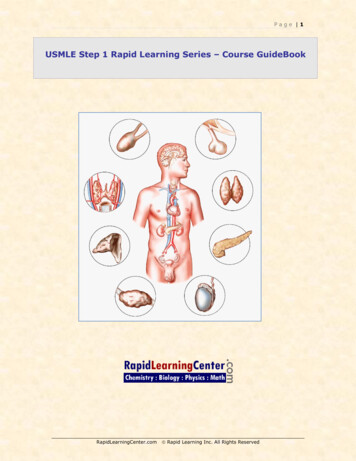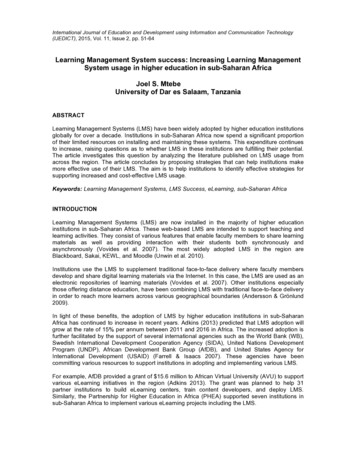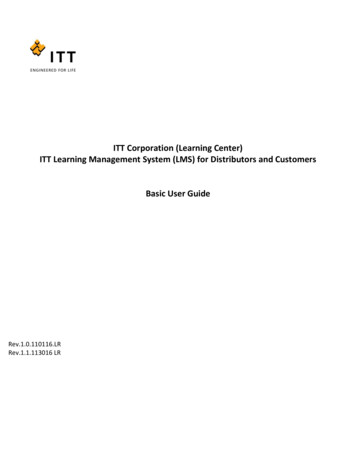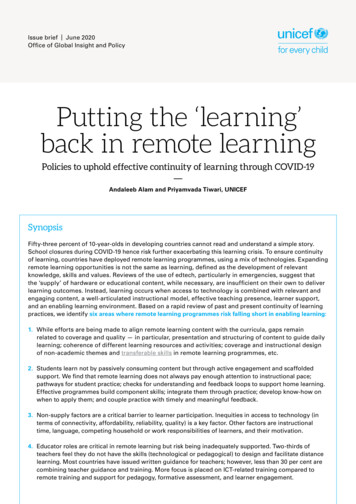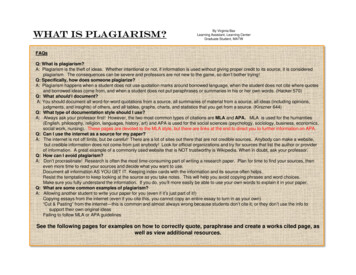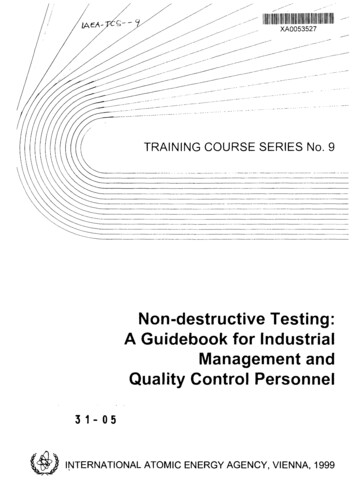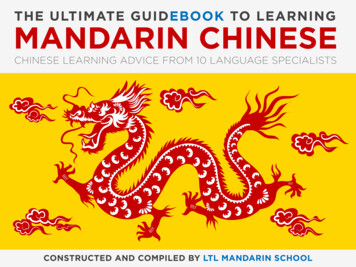
Transcription
THE ULTIMATE GUIDEBOOK TO LEARNINGMANDARIN CHINESECHINESE LEARNING ADVICE FROM 10 LANGUAGE SPECIALISTSCONSTRUCTED AND COMPILED BY LTL MANDARIN SCHOOL
CONTENTS1. Pronunciation and Tones – Getting your Mouth Around Chinese by Chris Parker32. Remembering Chinese Words by Benny Lewis73. Nĭ míngbái ma? – How to Improve your Chinese Listening Ability by Olle Linge114. Mastering Chinese Sentence Structure by Verena Menzel155. Maintaining Motivation to Study Chinese by Hugh Grigg206. Immersion Chinese for Dummies by Andreas Laimbock247. Expanding your Chinese from Outside of China by Richard Simcott288. How New Technologies can Help you Study Chinese by Sborto Zhou319. Learn Chinese by Having Fun! by Greg Bell3510. Your Best Methods for Learning Chinese Characters by Marcus Pentzek39THE ULTIMATE GUIDEBOOK TO LEARNING MANDARIN CHINESE2
CHAPTER 1PRONUNCIATIONAND TONESGETTING YOUR MOUTHAROUND CHINESEBY CHRIS PARKERLet me give you some good news: there are fewer sounds in Mandarin Chinese thanthere are in some other languages.This means you are going to hear and have to produce the same sounds again and againover time. It can be a bit confusing when you are listening and you hear a lot of similarsounds, but it’s something that plays into your hand in terms of speaking Chinese.One thing I always tell people is that as with any language, it’s a good idea to practicespeaking or at least get your mouth moving as early as you can. This is doubly so withMandarin, because some of the sounds may seem unusual to you, and you need tophysically get your mouth used to the mechanics of producing these sounds.THE ULTIMATE GUIDEBOOK TO LEARNING MANDARIN CHINESE3
FIRST TONEThe other thing, which you might have heard before, is that Mandarin Chinese also hasfour tone contours (four different ways of pronouncing any given syllable, plus otherunstressed syllables that are pitch neutral).In fact, every language uses intonation in some way or another, but as Chinese is a tonallanguage, the pitch and the way you say a syllable not only ‘changes the feel’ but candetermine the meaning of what you are saying.It sounds really difficult at the beginning, but it’s not really. To put it simply, the fourtones are 1) saying a syllable with a constant pitch 2) saying a syllable but raising yourpitch slightly towards the end almost like you are asking a question 3) a syllable that fallsthen rises in pitch and 4) a syllable that falls in pitch (almost like how you lower yourintonation at the end of a sentence).This is the kind of thing that isn’t going to make much sense in writing. The best thing isto start listening to the sounds of Chinese and start learning to recognize and producethem.To do that, you can go to a website that has a Pinyin table, such as the Yoyo ChinesePinyin Chart, the chart from Pinpin Chinese or the Chinesepod Pinyin Chart App.Pinyin is China’s Roman alphabet transcription system for Mandarin. It is also usedas a pronunciation guide in dictionaries, beginners’ courses, and you use it to typeChinese on a computer or phone. Learning how to represent Chinese sounds in Pinyin istherefore very important.THE ULTIMATE GUIDEBOOK TO LEARNING MANDARIN CHINESE54321SECOND TONE54321THIRD TONE54321FOURTH TONE543214
Go through the interactive table, checking through each sound, and practising sayingthem yourself in all four of the tones. It is worth getting over the embarrassment of‘sounding strange’ on your own first, so you become more and more comfortable withreproducing the sounds in Mandarin Chinese. What sounds like an ‘unusual sound’ atthe beginning will quickly become just like talking to you. After a long practice session orwhen you feel comfortable, get a friend to test you.Pick any syllable and tone combination, and try to pronounce it yourself, then clickon the syllable to compare your pronunciation to the native speaker’s. When you findout which syllables or tones you find difficult to pronounce, practice by imitating andcomparing yourself to the recording, until you improve.Arch Chinese has a website where you can listen to syllables and test whether you areable to recognize their tones. It’s also worth giving a go.When you are getting the hang of single syllables, you can also try recognizing tonesin pairs of syllables, or words. Sinosplice has a great free resource for practicing tonepairs. You can also try this game on the BBC learning Chinese website.At the beginning stage, it is important to get your mouth moving as much as possible,and imitate and practice the language. When you know Pinyin and you have practicedthe sounds of the language, you will be able to take to a course much more easily.It isimportantto get yourmouthmoving asmuch aspossible.It is really important to focus on the accuracy of your tones from the beginning – eventhough it is slow and painful. It may feel frustrating when you feel that you have to speakslower just to get the tones right.THE ULTIMATE GUIDEBOOK TO LEARNING MANDARIN CHINESE5
It might be tempting to try and speed up at the expense of your tones, but I wouldadvise you not to, as the pay-off from paying more attention at the beginning andspeeding up slowly will be clear later, when you find that you have built a goodfoundation and your Chinese is more accurate.It is easy to pronounce everything in a flat tone if you are learning Chinese, howeverif your tones are inaccurate, it will be very difficult to correct later, so it is worthconcentrating on pronunciation at the beginner stage.And most importantly, try to relax as you practise your speaking. Everybody makesmistakes with their tones, I still do sometimes even after more than 8 years, and don’tworry, people’s can generally understand even when you get them wrong, so don’t getdiscouraged, and remember: practice makes perfect!CHRIS PARKERChris Parker has been speaking Mandarin since 2006. He has worked as atranslator and simultaneous interpreter between Chinese and English, andhas taught interpretation in the UK and in Beijing. He now works in the media,specializing in international communications strategy and training. He blogs atFluent in Mandarin.YouTube »Facebook »THE ULTIMATE GUIDEBOOK TO LEARNING MANDARIN CHINESETwitter »6
CHAPTER 2REMEMBERINGCHINESE WORDSBY BENNY LEWISWhen learning Chinese, it can feel like you’re starting from absolute scratch, especiallywhen compared to European languages, which have much more of an overlap withEnglish than Chinese does.There are two tips I want to give to help you learn words faster – first I want you tonotice some words you already know, and then I’ll give a tip for remembering themajority of unfamiliar words you’ll come across much faster.While it’s true that most words you learn don’t resemble English at all, you’d be surprisedat how many Chinese words you know already. You would recognize these while spoken,and with a few minutes effort to get the tones right, you would be able to say themyourself without much mental effort.THE ULTIMATE GUIDEBOOK TO LEARNING MANDARIN CHINESE7
Here are just a few to get you started! Country names in many cases, especially for western countries, sound very similar tohow they do in English. For instance, 意大利 (Yìdàlì) for Italy, 波兰 (Bōlán) for Poland, 加拿大 (Jiānádà) for Canada, 哥伦比亚 (Gēlúnbǐyǎ) for Colombia. Many other countries havethe first letter or similar sound to the country followed by 国 guó (which means country),like 美国 (Měiguó) for America, 英国 (Yīngguó) for England and 法国 (Fàguó) for France. Some brand and person names like 可口可乐 (Kěkǒukělè) for Coca-Cola, 爱因斯坦(Àiyīnsītǎn) for Einstein, and 奥巴马 (Àobāmǎ) for Obama. Food and international concepts or words that Chinese would have borrowedrecently, like 拜拜 (bàibài) for bye-bye, 咖啡 (kāfēi) for coffee, 巧克力 (qiǎokèlì) forchocolate, 沙拉 (shālā) for salad and 咖喱 (gālí) for curry.That being said, you will have to learn a lot of new words. Mnemonics will make the jobmuch easier. Let me demonstrate through an example.When I started learning Mandarin, I needed to say the word “target” or “goal”, as I’doften describe my milestone three-month goal in the language. This word in Mandarinis pronounced mùbiāo. This doesn’t look or sound anything like its English equivalent.So I came up with a story by trying to think what I could do with “moo” (falling tone) then“bee-ow” (first tone), and try to tie that story into the concept of “target”.THE ULTIMATE GUIDEBOOK TO LEARNING MANDARIN CHINESE8
If you’re attempting to come up with mnemonics yourself, use any idea that comes tomind! It doesn’t matter how silly, nonsensical, politically incorrect, sexual, or personal toyour tastes it may be.When I first saw this word, I gave it a minute and then this story came to me:I’m walking through a field with a bow and arrow in the early evening as the sun issetting. I want to practise my shooting skills, but don’t see something challenging toaim for. Suddenly a cow falls from the sky!MOOOoooooo [CRASH].She stumbles to find her ground, and I see my opportunity! Conveniently, a bulls-eyeof concentric red and white circles has been pre-painted on her rear, and I positionmyself by kneeling a little so that the bow is at the same height as the poor cow’s ass.This is no ordinary bow and arrow though! My arrow is made entirely of bees. I pull itback and launch it straight ahead – since I positioned myself correctly it flies straightinto the target and hits the cow’s bum!The poor animal forgets itself, and rather than moo she can’t resist but yelling a loud“OW!”(No animals were harmed in the making of this mnemonic).THE ULTIMATE GUIDEBOOK TO LEARNING MANDARIN CHINESE9
The story takes a couple of minutes to write out, but our brains work much faster whenwe don’t need to verbalise our thoughts. Basically allI see in this story is [target: mu (falling tone), bee-ow (first tone): target].The visual aspect of this mnemonic also helps me remember the tones, and making surethat the actual meaning is ever present allows it to be practical for both recognition ANDfor production.Try it out for yourself!BENNY LEWISBenny Lewis could only speak English when he was 21, but in the last 12 yearshe has travelled the globe, diving deep into other cultures and even winningthe title of National Geographic’s Traveler of the Year. His blog Fluent in 3Months is read by over a million visitors each month, and his book of thesame title was an international best seller. He has tackled many languagesincluding Chinese, and after successfully reaching basic conversational stagein Mandarin in just a few months, has written a guide to encourage Chinesebeginner learners called Why Chinese is Easy.THE ULTIMATE GUIDEBOOK TO LEARNING MANDARIN CHINESE10
CHAPTER 3NI MINGBAI MA?How to improve yourChinese Listening abilityBY OLLE LINGEWhy and how to improve listening abilityYou ask for directions, but don’t understand the answer. You get whatyour teacher says, but strangers seem to speak a different language. Youhang out with Chinese people, but find it hard to catch what they sayamong themselves.Does this sound familiar? These are all common complaints fromstudents, partly because listening practice is often overlooked by bothstudents and teachers of Chinese. Yet, I think listening ability is the mostfundamental skill. Good listening ability opens many doors, while poorlistening ability confines you to your own bubble and slows down yourlong-term progress. In this article, I’m first going to explain why this istrue, then move on to how you can improve your listening ability.THE ULTIMATE GUIDEBOOK TO LEARNING MANDARIN CHINESE11
Why is listening ability so important?Listening ability is important for many reasons. First, it helps you integrate with nativespeakers. Not being able to understand what’s going on is often worse than beingunable to express yourself.Furthermore, the more you understand, the more likely you are to absorb the languagesimply by exposing yourself to it. This will never happen if your listening ability is poor.Better listening ability also carries over to other skills in some unexpected ways. Forexample, many studies show that you can improve pronunciation simply by trainingyour ability to hear the sounds of the language. However, you don’t learn to understandothers by speaking yourself. Listening and paying attention to how native speakersexpress themselves is the best source for learning words, phrases and grammar.But wait, if your goal is to be able to speak Chinese, doesn’t it make more sense topractice just that? In a conversation, you’re not the only person speaking and youcertainly learn from what other people say. Communication is the purpose of languageafter all. This is all true, but the problem is that for most people, getting enough listeningpractice through real conversations is impractical. You have to find people who arewilling to talk to you and you become dependent on them. They also adjust theirlanguage. You should of course speak as much as possible with native speakers, but totruly reap the benefits of good listening comprehension, you need to do more than that.THE ULTIMATE GUIDEBOOK TO LEARNING MANDARIN CHINESEYoucertainlylearn fromwhat otherpeople say.12
How can you improve listening ability?The first step should be to listen more. You can combine listening with many other dailyactivities, so even if you’re studying in your home country and work full time, you canstill fit in many hours of listening each week. Try listening while doing household chores,working out, going for walks, eating and before falling asleep at night. The key here is tomake sure you always have audio with you and that it’s easy to access. Buy a few extrapairs of earphones, download audio in case you don’t have internet access, get a smallmp3-player to use in case of emergencies.What should you listen to?Listen to different types, genres and topics. Also listen to many different speakers. As faras possible, choose audio you can mostly u
While it’s true that most words you learn don’t resemble English at all, you’d be surprised at how many Chinese words you know already. You would recognize these while spoken, and with a few minutes effort to get the tones right, you would be able to say them yourself without much mental effort. REMEMBERING CHINESE WORDS BY BENNY LEWIS CHAPTER 2 7. THE ULTIMATE File Size: 1MBPage Count: 47
